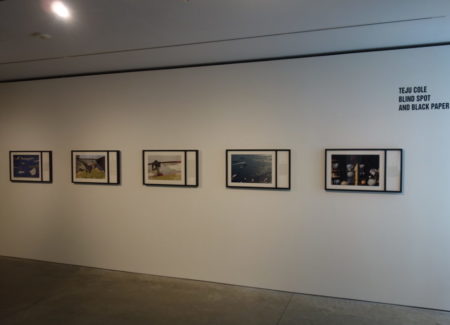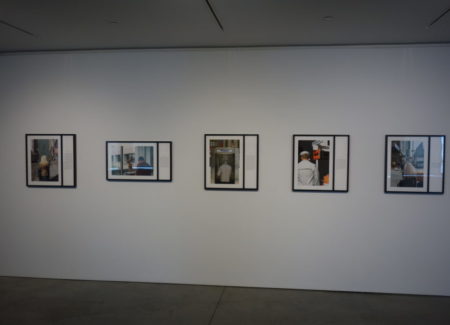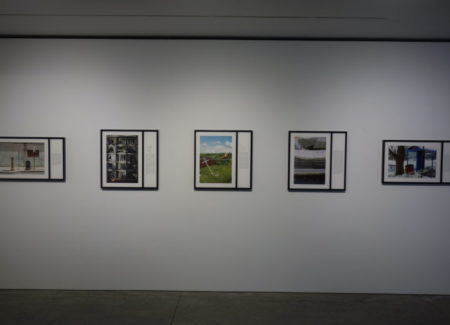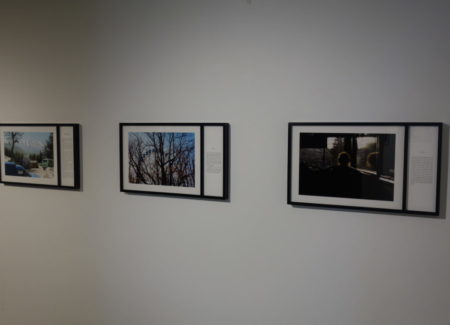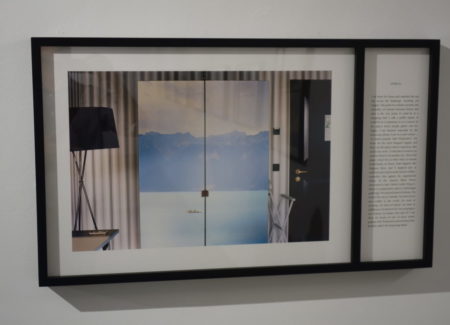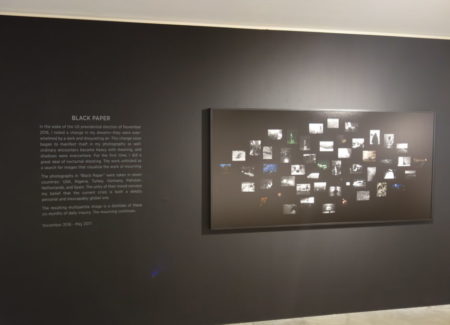JTF (just the facts): A total of 33 color photographs, framed in black and unmatted, and hung in the main gallery space (separated by a dividing wall). 32 of the works are archival pigment prints (mounted together with text panels), made between 2013 and 2016 and printed in 2017. Overall physical sizes are either 19×32 or 26×25, and all of the works are available in editions of 5+2AP. A single larger work (hung against a black wall) is an archival pigment print, made between November 2016 and May 2017. It is sized 48×84 and is available in an edition of 2+1AP. (Installation shots below.)
A monograph of this body of work entitled Blind Spot was published in 2017 by Random House (here). Hardcover, 352 pages, with 157 color photographs. (Cover shot below.)
Comments/Context: Back in 1973, the Museum of Modern Art published a highly unorthodox survey of its photography collection entitled Looking at Photographs. Of course, curators and historians had been writing about photography since the medium’s invention, so adding some explanatory text to a selection of images wasn’t in any way a new idea. But curator John Szarkowski’s single page essays (that were placed to the left of the individual photographs in the book) were nothing short of revelatory. They brought together historical facts, short anecdotes, background information, critical interpretation, and lyrical description in ways that were surprisingly resonant and conversational. To this day, his thoughtful characterization of a Carleton Watkins’ 19th century image of a strawberry tree as “as simple as a Japanese flag and as rich as a dictionary” is still simply magical, in a way that previous writing about photography had failed to rise to such lofty heights. Reading his essays was like traveling along the backroads of photography with a knowledgeable friend, one who could relate an entertaining story and explain a picture with a measure of understated and inclusive grace.
Looking at Photographs is, in many ways, an important predecessor to Teju Cole’s new show (and photobook) Blind Spot. Cole is likely best known as an accomplished writer, with two well regarded novels and a book of essays under his belt. But his interest in photography is clearly more than just a side hobby – he has been shooting and taking workshops for years, and his “On Photography” column for the New York Times Magazine has quickly become a consistently thoughtful venue for contemporary discussion of photography. In his essays about photography, he has moved beyond straightforward feature writing and criticism, pushing toward something more amorphously meditative, where like Szarkowski, he has allowed his thoughts to wander, following various references and connections in developing his lines of thinking and pursuing his inquiries.
That Cole’s photographic artworks would end up being a healthy marriage between pictures and text is perhaps not surprising, but few have engineered such a combination with the cerebral sophistication that Cole exhibits here. Each photograph acts like an initial catalyst, providing Cole with various jumping off points for close aesthetic analysis, diaristic anecdote telling, and more esoteric and intellectual ruminations and reflections. His concise captions/essays (framed together with the photographs like a pair of windows) have the drifting cadence of conversations or short vignettes, his deliberate storytelling similar to an act of careful verbal processing, each set of words an active engagement with a picture and all that it might represent.
While we often consider the power of a photograph as lying in its ability to have multiple, open-ended interpretations, Cole’s words inevitably push us toward a particular way of seeing his pictures. His approach is characterized by a gentle brand of intellectualism, a brainy but welcoming voice that wants to tell us what he’s been thinking. There is a rhythm to his reflections that is best seen in the pacing and sequencing of the book, but it leaves traces on the gallery walls as well. Like poets in the oral tradition, he connects back to tales we know to keep us grounded – he alludes to Biblical myths and Greek tragedies, to art house movies, to the origins of language, and to political unrest, and then merges his own personal memories and recollections into this broader flow in search of resonant patterns.
As a 21st century novelist and teacher with a calendar filled with readings, talks, and lectures, Cole is nothing if not a globe trotter, and his photographs and stories inevitably fall out of this continually on-the-go lifestyle. From upstate New York to Lagos, with itinerant stops in everywhere from Switzerland and Italy to Lebanon and Indonesia, his travels have taken him far and wide, his citizenship of the world often accompanied by the dislocating feel of being an outsider. His recurring solution to this jet-lagged estrangement has been to go walking, losing himself in cities and towns around the world, letting chance take him where it may.
If any of this sounds vaguely familiar, in the vein of the Baudelarian image of the literary flâneur, it should – Cole seems to have adapted this model to the realities of his contemporary life. Armed with his camera, his strolling is both aimless and highly attentive, directionless yet directed, the slowness of the pace allowing him to carefully examine life on the streets, where the chaotic juxtapositions of buildings, signs, murals, construction sites, and other quirks and commonalities of human existence can coalesce into something of interest. In the tradition of Eugène Atget, and then in the footsteps of countless street photographers since, Cole uses photography to mediate (and document) his experience of the “city”. And from there, he uses the power of his words to transform each image into a myriad of meanings and imaginings.
Photographically, Cole’s images feel very precisely assembled, and with the plotted intricacies of his texts as a guide, this seems altogether predictable. He is intrigued by the balance of line and form, the process of framing and compositional construction, the recognition of pattern, repetition, and reflection, and the transformation of representation into something closer to abstraction. Having already mastered visualization in language, in many ways, he has used photography to explore visualization in imagery (in effect relearning to see), and his words follow that circuitous lead, “seeing” sounds, “hearing” colors, and investigating invisible landscapes.
His awareness of the history of the medium and his reverence for many of its masters combine to fill this body of work with earnest aesthetic echoes – to the serendipitous charm of Luigi Ghirri, to the everyday isolations of Eggleston and Shore, to the layering of Alex Webb and Raghubir Singh, and even to the deliberate interruptions of Friedlander. Again and again, Cole’s photographs feel rooted in what he knows, and only a few step beyond that learned framework to crystalize a singular visual voice (and vocabulary) of their own.
But while many of Cole’s found oddities might feel familiar (or even derivative), his integrated image/text artworks have a vitality that is undeniably original. The wispy expressiveness of his words encourages us to see more than just a window display of globes, a white-uniformed sailor at Ground Zero, a grubby snow encrusted bus stop, or a painted mural on a hotel armoire. The photographs are well made, but the writings give them wings – a boy hanging from a red railing is suddenly carrying a cross (and all that such a Christian metaphor implies), laundry blowing in the wind leads to a discussion of peripheral vision and Troxler’s fading, a slit in a transparent construction tarp becomes an echo of Caravaggio, and a layered grey composition of textural sidewalk, roadway, and construction leads to a meditation on translation and in-between silence. In short, the success of the artworks is firmly planted in watching Cole’s active mind simultaneously at work in two different but interrelated artistic planes.
This interplay is notably absent from his most recent work, Black Paper, and it feels like a missed opportunity. The wall filling collage of images made after the 2016 Presidential election in the United States is filled with dark moods, its night shots, graffiti, shadows, and repeated visual blockages creating an all-over sense of persistent anxiety and simmering uncertainty. While this assemblage may indeed be representative of both Cole’s personal reaction to the events as well as that of a major slice of the population at large, the ideas feel transitory and loosely gathered, lacking that splash of reflective intellectual wrestling that enlivens and directs his other work.
The innovation in Cole’s photography comes in the recognition that clever visual observations aren’t an end point but an intriguing beginning. His internal thoughts and external references, his casual stories and serious allusions, they all come together to form a rich context for his photographic discoveries, wrapping them in reassuring twists of thoughtful memories and contemplative meditations that add to their weight. Being a novelist makes Cole a unique kind of photographer, and by leveraging his expansive talent with words, he infuses his images with a personal brand of poetic intensity.
Collector’s POV: The works in this show are priced as follows. The image/text combinations from Blind Spot are $3500 each, while the large Black Paper work is $20000. Cole’s work has little secondary market history at this point, so gallery retail remains the best option for those collectors interested in following up.

